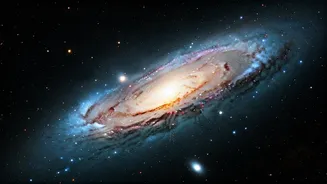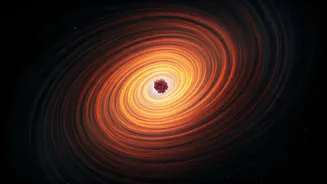Earth's Vivid Views
Several images in the collection focus on Earth, highlighting its diverse landscapes and natural phenomena. One image might showcase vibrant coral reefs,
captured from space, revealing the health and beauty of these underwater ecosystems. Another could depict the swirling patterns of a hurricane as it moves across the ocean, demonstrating the power and scale of weather systems. There could also be a photograph of vast deserts, showing the intricate textures created by wind and sand. Each image would offer a unique perspective on our planet, encouraging viewers to appreciate the delicate balance of Earth's environment and the importance of its preservation. The colors, textures, and details within the photographs would provide a sense of the world's beauty and complexity, all seen from the vantage point of space.
Beyond Earth's Horizon
The collection also includes images that venture far beyond our planet, offering glimpses into the mysteries of the cosmos. A striking photograph might present a nebula, a vast cloud of gas and dust where stars are born. The vibrant colors and intricate shapes of the nebula would be a testament to the creative forces at work in the universe. Another image could reveal a distant galaxy, containing billions of stars and planets, each a potential world of its own. The scale of such images would be difficult to fathom, underlining the sheer vastness of the cosmos. These images would not only inspire awe but also provide valuable scientific data, helping astronomers understand the processes that shape the universe. Every image would provide a window into the unknown, urging humans to continue exploring and discovering.
Detailed Astronomical Insights
The images are not simply for aesthetic appeal; they serve a critical function in scientific research. Scientists use these images to study a variety of astronomical phenomena, from the birth and death of stars to the formation of galaxies. For instance, an image of a supernova remnant could allow astronomers to study the expanding cloud of gas and dust left behind by a dying star, providing insights into stellar evolution. Another picture might focus on a distant quasar, an incredibly luminous object powered by a supermassive black hole, to investigate the behavior of matter under extreme gravitational conditions. By analyzing the light and other forms of radiation emitted by these objects, scientists can gather valuable information about their composition, temperature, and motion. These images, therefore, are essential tools for advancing our understanding of the universe and its mysteries, making them invaluable to the scientific community.
The Art of Photography
The creation of these images is a complex process, a blend of science and artistry. NASA scientists and photographers work in tandem to capture and process these stunning visuals. Specialized telescopes and cameras are employed to gather data, often in different wavelengths of light. The data is then processed and colorized, creating the final images. Sometimes, the color palettes are selected to highlight specific features or elements, enhancing the visual impact. The aim is to present the data in a way that is both scientifically accurate and visually compelling. The photographers and scientists must consider the aesthetics, ensuring the images are not only informative but also visually appealing. The effort to craft these images into artworks requires meticulous planning and creativity, making each image a testament to the dedication and skill of the individuals involved.
Inspiring Future Explorers
Beyond their scientific value, these images also serve to inspire and educate the public. They spark curiosity about the cosmos and encourage a deeper appreciation for the wonders of the universe. The stunning visuals capture the imagination, prompting people to wonder about the possibilities that exist beyond our planet. The collection is often used in educational materials, helping teachers and students learn about space science in an engaging way. The images also appear in museums and galleries, offering visitors a chance to experience the beauty and scale of the cosmos up close. They have the power to motivate the next generation of scientists, engineers, and explorers, fostering a sense of wonder and encouraging them to pursue careers in STEM fields. The impact of these images goes far beyond the scientific community, reaching out to touch and inspire people around the world.




